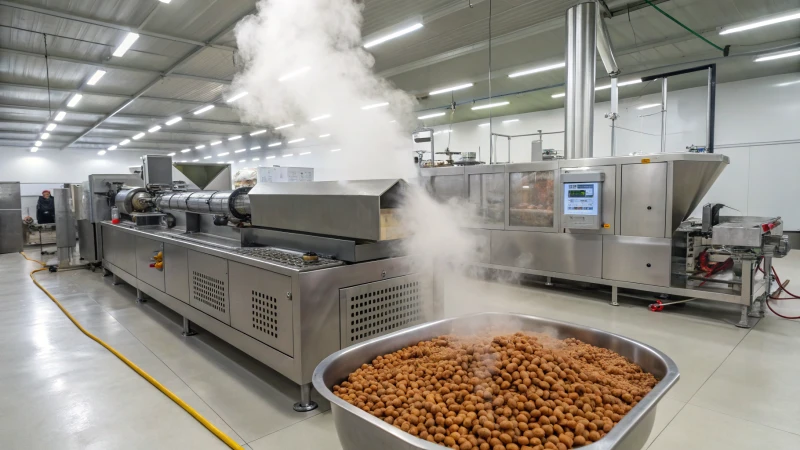
Energy efficiency is a critical factor in pet food production. High energy consumption can significantly impact operating costs, sustainability goals, and overall production efficiency. Manufacturers are increasingly prioritizing energy-efficient technologies to reduce costs and align with environmental standards. However, the efficiency of a pet food production line depends on factors such as equipment design, operational practices, and the type of products being manufactured.
Modern pet food production lines are highly energy-efficient, consuming an average of 50-300 kWh per ton of finished product, depending on the production scale, product type, and level of automation. Energy efficiency is further enhanced by advanced technologies such as high-performance extruders, waste heat recovery systems, and optimized motor drives, which can reduce energy consumption by up to 30-40%.
Understanding the key contributors to energy efficiency and strategies to improve energy use is essential for manufacturers seeking cost-effective and sustainable operations. Let’s explore these factors in detail.
Factors Influencing Energy Consumption in Pet Food Production Lines
The energy efficiency of a pet food production line is influenced by multiple variables, including the type of equipment, process design, and the nature of the product being manufactured.
1. Equipment Efficiency
Modern production lines are designed with energy-efficient components to minimize power consumption while maintaining productivity.
| المعدات | Energy Usage (kWh/ton) | Efficiency Features |
|---|---|---|
| Extruder (Dry Kibble) | 30-100 | Direct-drive motors, insulated barrels, etc. |
| Mixer/Blender | 10-25 | Variable-speed drives (VSDs) |
| Dryer (Thermal Processing) | 50-150 | Waste heat recovery, moisture sensors |
| ماكينات التعبئة والتغليف | 5-20 | Servo motors, energy-efficient actuators |
Key features like variable-speed drives (VSDs), high-efficiency motors, and smart control systems help optimize energy use at each stage of production.
2. مقياس الإنتاج
- الإنتاج على نطاق صغير: Typically consumes less total energy but has higher energy usage per ton due to inefficiencies in operating smaller equipment.
- الإنتاج على نطاق واسع: Benefits from economies of scale, resulting in lower energy consumption per unit of production.
3. نوع المنتج
- أغذية الحيوانات الأليفة الجافة: Requires significant energy during extrusion and drying processes.
- أغذية الحيوانات الأليفة الرطبة: Demands energy for cooking, sterilization, and packaging.
- المنتجات المتخصصة: Grain-free or high-protein products may require additional energy for processing unique ingredients.
| نوع المنتج | Average Energy Use (kWh/ton) |
|---|---|
| طعام جاف | 150-300 |
| الأطعمة الرطبة/المعلبة | 100-200 |
| Freeze-Dried Products | 200-400 |
4. Automation and Process Optimization
Highly automated production lines are more energy-efficient due to precise control over variables such as temperature, mixing time, and machine speed. These optimizations reduce energy waste and improve overall efficiency.
Energy Optimization Technologies in Pet Food Production
1. آلات البثق عالية الكفاءة
- المزايا: Modern extruders use direct-drive motors and insulated barrels to reduce energy consumption during the cooking and shaping processes.
- التأثير: Up to 20-30% reduction in energy use compared to older models.
2. Waste Heat Recovery Systems
- كيف تعمل: Captures heat from exhaust systems (e.g., dryers) and reuses it in preheating or other processes.
- التأثير: Reduces thermal energy use by 10-15%.
3. Variable-Speed Drives (VSDs)
- الغرض: Adjusts motor speed to match production requirements, preventing unnecessary energy use.
- التأثير: Saves up to 40% of energy in motors.
4. Energy Monitoring Systems
- كيف تعمل: Uses sensors and IoT devices to monitor energy usage in real-time, identifying inefficiencies.
- التأثير: Enables targeted energy-saving interventions, reducing overall consumption.
Comparative Energy Efficiency Metrics
To better understand energy efficiency, here’s a comparison of a traditional production line versus a modern, energy-optimized line:
| الفئة | Traditional Line | Energy-Optimized Line |
|---|---|---|
| Energy Use per Ton (kWh) | 250-400 | 150-250 |
| Waste Heat Utilization (%) | <10 | 20-30 |
| مستوى الأتمتة | منخفضة إلى متوسطة | عالية |
| CO2 Emissions (kg/ton) | 300-500 | 150-300 |
استراتيجيات تحسين كفاءة الطاقة
1. Upgrade to Energy-Efficient Equipment
- Replace outdated machinery with energy-efficient models.
- Focus on key areas like extruders and dryers, which consume the most energy.
2. Optimize Process Parameters
- Reduce overprocessing by fine-tuning variables such as mixing time and drying temperature.
- Use moisture sensors to prevent over-drying.
3. Implement Energy Recovery Systems
- Install heat exchangers to reuse waste heat for drying or preheating.
4. الصيانة الدورية
- Ensure that motors, belts, and bearings are properly maintained to avoid energy losses.
Real-World Example: Energy Savings from Optimization
A pet food manufacturer upgraded its production line with energy-efficient extruders and waste heat recovery systems. Key results included:
- توفير الطاقة: 25% reduction in electricity costs.
- العائد على الاستثمار: Recouped investment within 2 years through energy savings.
- الأثر البيئي: Reduced CO2 emissions by 15%.
الخاتمة
Modern pet food production lines are increasingly energy-efficient, with average energy consumption ranging from 50-300 kWh per ton of finished product. Key contributors to energy efficiency include advanced equipment design, process optimization, and waste heat recovery systems. By investing in energy-efficient technologies and adopting best practices, manufacturers can reduce operating costs and improve sustainability.
دعوة إلى العمل
Looking to optimize energy consumption in your pet food production line? Contact us today for expert advice on energy-efficient technologies, customized solutions, and sustainability strategies. Let us help you reduce costs and enhance operational efficiency!









